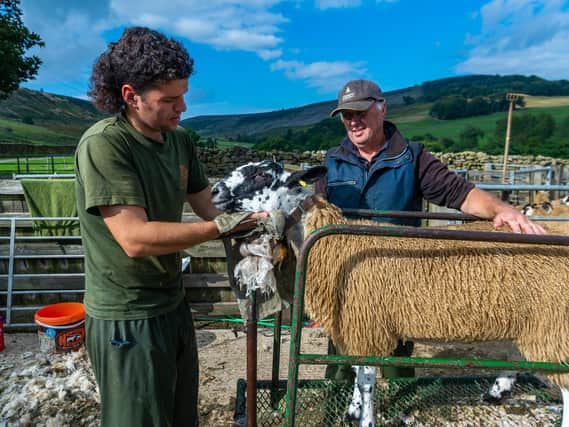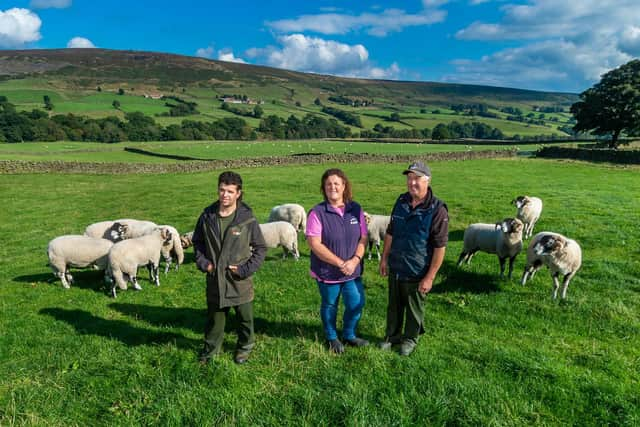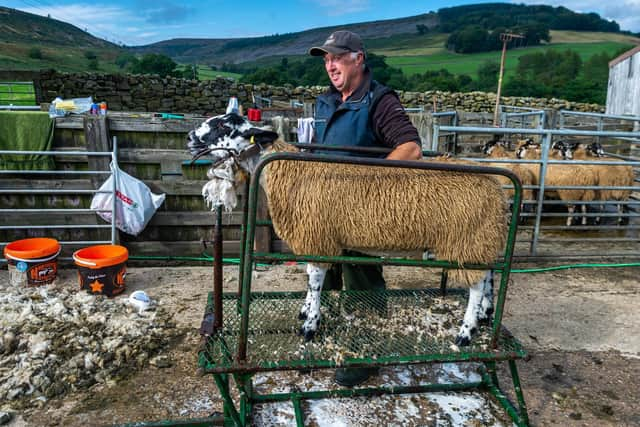Farm of the Week: Running an ancient Swaledale flock and keeping a centuries-old tradition alive in the North York Moors


Tim Dunn farms at Breck House in one of Yorkshire’s most unspoilt and tranquil dales that is also home to his historic hefted flocks on the moors above. These are the sheep that form the basis of his farm enterprise.
Tim and his son James, known to everyone as Jim-Bob, have 1,400 breeding ewes of which 1,300 are Swaledales. Hefted hill sheep pass their knowledge on from ewe to lamb in each generation to understand their natural habitat is up on the moor where they live without fences or walls. Father and son keep 800 of their Swaledales up on the moors above Bransdale and Bilsdale.
Advertisement
Hide AdAdvertisement
Hide AdTim and his wife Sarah also have in-bye land below the moor line, of 230 acres at Breck House tenanted from the National Trust and 133 acres they own at Rosy Dike. The in-bye land is where the other 500 Swaledales are kept that are crossed with the Bluefaced Leicester tup to produce the North of England Mule.


Tim said that his and Jim-Bob’s passion for Swaledale sheep revolves around their hefted background and that it needs preserving.
“A hefted flock is a living ancient monument. Some have been on the moors for centuries and if they ever disappear it will be a crime. The way environmental schemes are going there are already far less sheep on the moors. Swaledales are the best sheep for roaming and foraging.
“Our 800 Swaledale ewes on the moor are to breed our replacements and will normally produce just one lamb each year for three crops. Once she has had those we bring her down to the in-bye where she is crossed with a Bluefaced Leicester and her prolificacy will go up to nearly two lambs per year for her next three crops and she will often keep producing North of England Mule lambs for even longer."
Advertisement
Hide AdAdvertisement
Hide AdTim and four other members of the Swaledale Sheep Breeders Association ‘E’ District have recently taken part in a performance recording scheme. Tim said the time was right for data to back up the breed which he feels is the best.


“Lowland breeds have gathered data for many years to help them explore the genetics to produce the growth rates, muscle depth and very little fat they are looking for in producing butchers’ lambs. We are now using data too and it is helping.
“For Swaledales it is different. Up on these Moors carrying fat is a necessity, so we select tups that carry as much muscle as they can but also plenty of fat because the ewes need that so they can hold condition on the hills.
“Our performance recording was of Swaledale tups. We found there was a huge difference between the lambs produced from one tup to another. We had one tup whose lambs were growing at 40g a day faster than the others. Our Swaledale lambs born on the moor normally average around 110g a day growth rate. That’s a large percentage increase.
Advertisement
Hide AdAdvertisement
Hide Ad“That tup’s lambs, when finished, were also found to have an extra rib, creating two extra lamb chops and as someone in the meat trade told me that butchers are now cutting chops into two, it means that tup’s lambs were creating four additional lamb chops.
“It is alright sheep farmers thinking that one lamb looks better than another but seeing the data in black and white or on screen is irrefutable. When we backfat scanned we found that the top 30 lambs out of 600 scanned were all by that one tup. It also showed that the bottom 20 were all from a different tup. For me that’s the main thing. It shows which poorer performing ones need to go.
“In my eyes we had always been producing the best breed that goes on to produce the best crossbred, the Mule. We just hadn’t been backing it up with data. Now we are. We started out with the performance recording on a three-year project through Defra, but the five of us are now keeping it going because we can see its value.
The North of England Mule and Bluefaced Leicester annual sales are as much a part of the autumn sheep sale harvest as the Swaledale.
Advertisement
Hide AdAdvertisement
Hide AdTim said the Mule has always interested him and that he still sees it as the major player following on in the hill to lowland sheep breeding pyramid.
“I have been scanning ewes for lambs for over 30 years and I have seen a lot of breeds come and go but nearly everybody relies on the Mule ewe. She will have loads of lambs, provides lots of milk to feed them well and she is so easy to farm.
Sheep scanning now takes up most of Tim and Jim-Bob’s time from mid-December to the end of February. Last year they scanned 131,000 ewes across North Yorkshire. Tim started scanning in the 1985/86 lambing season with his father Chris after undertaking a project at Newton Rigg College where he was studying in 1984. They scanned 16,000 that first year.
Tim said it has provided the farm business with a regular income ever since.
Advertisement
Hide AdAdvertisement
Hide Ad“Farming is always in our heart, but financially, scanning is now a massive part of our business. When you are scanning you are an earning an hourly rate whereas when you’re on the farm you’ve no idea what you’re earning per hour.
“Up until four years ago when Jim-Bob joined me I was scanning 115,000 a year. He scanned 56,000 last year and I did 75,000. It has really helped with Jim-Bob on board. I can now spend a little more time with people who have become more like friends than customers.
“My time at college was when I got the bug for Swaledales. I came home with the idea of producing better Swaledale tups. We then started breeding our own Bluefaced Leicesters. Finding out that best match of Swaledale and Bluefaced Leicester strains and the genetic breeding side has always interested me.
Tim and Jim-Bob’s lambing time is from the end of March into April. They AI the 500 Swaledales put to the Bluefaced Leicester more or less in one day so that all Mule lambs are born within a few days from 28 March.
Advertisement
Hide AdAdvertisement
Hide AdTim said he will take Swaledale tups to sell at the breed sales at Ruswarp and Hawes, as well as selling some from Breck House.
“I’m on the Swaledale ‘E’ District council whose sale is at Ruswarp, so it’s my duty to keep that sale going well. We show at Ryedale Show and that is usually a good barometer for us. We also support the Mule gimmer sales at Hawes and Wombleton and our local shows at Bilsdale and Farndale by showing our Swaledales.
Breck House has also recently hosted Tim and Sarah’s daughter Katherine’s wedding to Alastair Wilkinson and a North of England Mule Sheep Association Open Day that attracted over 400.